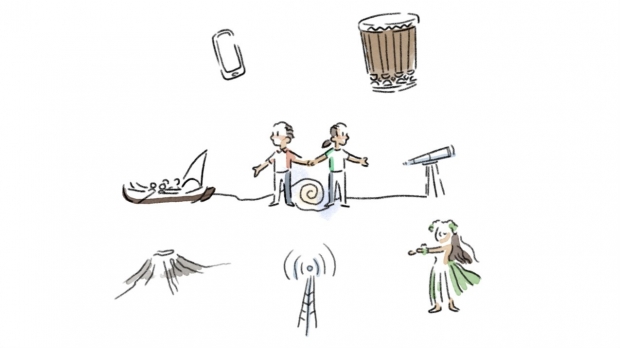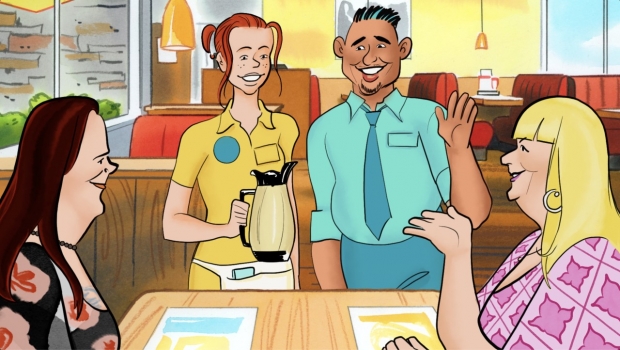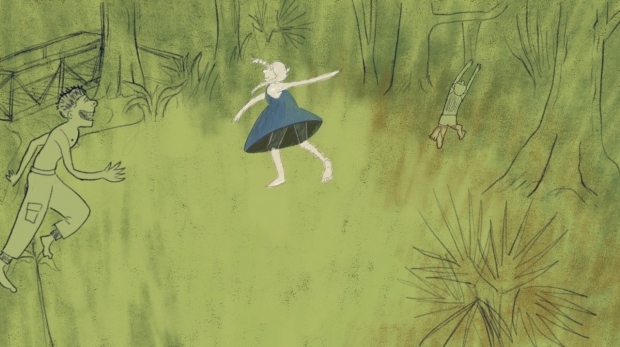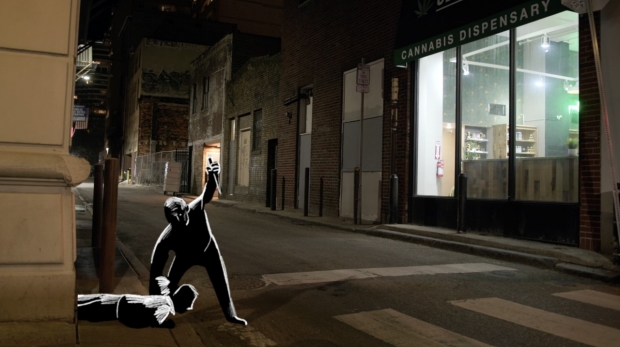For the Ace & Son studio founder, finding projects that matter, that focus on the complexities of living in a flawed world, brings purpose and sustainability despite the financial challenges, like the pro bono music video for The Exbats’ ‘Doorman,’ inspired by 'Superjail’s Christy Karacas, about a girl who wants to beat up a bar bouncer.
Between the Lions was one of the more obscure shows PBS produced back in the early 2000s, combining animation, live-action, and puppetry to teach kids to spell and read… along with noir detective spuds, swirly-eyed jokers, living statues, ‘fuzzy wuzzy’ balding bears, and orangutans in wigs. There were very few limits on what kinds of characters and media could inhabit this imaginative TV program.
But while the series, now off the air for 14 years, exists for some viewers only in the recesses of their childhood memories, the show was a notable launchpad for animator and Ace & Son Moving Picture Company founder Richard O’Connor, who was inspired and constantly amused by the unique creativity of the showrunners. And, if Between the Lions’ 10 Daytime Emmy Award wins is any indication, O’Connor certainly wasn’t the only one engaged.
“It was run by great people,” he remembers. “Chris Cerf was a titan of children's programming and had been a musician for Sesame Street. Norman Stiles was a head writer for Sesame Street for many years, and Michael Frith was the former executive vice-president and creative director of The Jim Henson Company and was a puppeteer. These were all enormously creative people who were interested in entertaining the parents while educating the kids. No kid is going to get that Sam Spud is a Sam Spade reference. But adults got it, and that was part of the fun.”
O’Connor started in animation production right out of college, working first for The Ink Tank in New York, which produced Between the Lions, a world where no one questioned why popcorn regularly overflowed out of puppet pants and where 2D, cut-out, and 3D animation lived in harmonious innovation. O’Connor worked at the studio for about a decade before joining up with producer friend Brian O'Connell to start their own animation shop, Asterisk, which lasted eight years. Since 2011, O’Connor has been flying solo as producer and director of his own animated projects at Ace & Son, which has taken – and run with - Between the Lions’ eclectic media aesthetics.
Ace & Son’s animation is primarily drawing-based, 2D animation, but it varies by project. Just a couple months back, the studio utilized stop-motion for a music video they were hired to animate for English pop rock band Dexys’ "Coming Home." For their broadcast segments and commercial projects, Ace & Son has worked with NBC Sports, PBS, Academy of Motion Picture Arts and Sciences, Oprah Winfrey Network, State Farm, Sesame Workshop, and more. They’ve also produced dozens of documentaries and short films.
“We usually do a self-generated short film once a year,” says O’Connor. “We're also finishing up another music video right now, which is kind of self-generated as well. I heard a song on the radio a year ago by The Exbats, which is a father-daughter duet. She was in high school when they started the band, and now, she’s a teacher, like her dad. She teaches third grade but sings this stuff about wanting to have sex with Bucky Barnes from Captain America. It’s pretty hilarious.”
The project is completely pro bono and focuses on The Exbats’ "Doorman" song, released in 2020. O’Connor admits he and the team have been having a heck of a fun time with the video. Maybe too much fun.
“It’s a bit more cartoon violence-heavy and totally ridiculous because it’s about a girl who wants to beat up the bouncer at a bar,” explains O’Connor. “I’ve wanted to do something like this for a while, and we’ve been inspired by Christy Karacas on it, who made Superjail for Adult Swim, which is also a very violence-heavy series.”
Most of the pieces showcased at O’Connor’s current studio, which mixes traditional processes with contemporary techniques, have been made by just a handful of artists. The studio itself usually only works with seven or eight staff artists, including Taisiya Zaretskaya, Natalie Greene, Ruyin Tsai, Pilar Newton, Morgan Miller, Chris Harper, Keenon Farrell, and frequently Rose Stark, with everyone contributing to nearly every stage of production while gravitating towards the specific work they most enjoy, such as animations of heavily shadowed court cases or glass-painted reflections of autism.
In one segment of Jill Jones’ documentary, Spectrum: A Story of the Mind, artist Judy Endow is featured narrating her painting process and how she aims to visually represent the way her autism influences the way she processes information.
“You see this stop-motion technique with paint on glass used in Aleksandr Petrov’s The Old Man and the Sea, and my friend Anne Beal does this stuff too,” notes O’Connor. “We actually worked together on another project last year for the town of Wailuku in Maui. We ended up doing 12 films overall using watercolor on waxy paper. The animated films were interpretations from SMALL TOWN * BIG ART’s Talk Story series, which premiered at the Historic ʻĪao Theater, exhibited at Wailuku Coffee Company, and were featured at the 2022 Maui Film Festival.”
The stories Ace & Son has worked on – the rise and fall of taxidermists, breakdowns of different societies' past and present honor codes, oral histories of the Holocaust, and even O’Connor’s own family holiday memories – all focus primarily on the complexities of living in a deeply flawed and, at times, still very beautiful world. For Ace & Son, the story and the messages come first; even if the type of animation work isn’t enticing, the studio will hop on board if the project proves important.
“I tell people I started Ace & Son because I didn’t think anyone else would hire me,” jests O’Connor. “But that’s mostly a joke. Really, I just like an environment where everybody who's working together has a stake in the labor and the work. And there was no guarantee that I would wind up at a place that allowed for having ownership over one’s creative process and where everyone could claim equal ownership of the project.”
He continues, “But it’s been hard because sometimes the work that I want to do might not be as financially rewarding. Carrying the big overhead, making sure everybody gets paid their dues is not always the easiest thing since we don't have an infrastructure in the U.S. that supports working artists.”
Regardless, O’Connor is very vocal on the studio website about making sure Ace & Son projects are always done with purpose. It’s a precarious dance between that purpose and building a sustainable business. “We’ve done safety procedure widgets for companies like Boeing, which helps me pay people and keep the lights on,” he shares. “Let’s be honest. I’ve still got a cat to feed. They aren’t always the most exciting projects, but they’re what gives us the room to do the creative stuff we love. We've also been fortunate for the past several years that we've had long-term contracts.”
Most recently, O’Connor and his team produced an animated project called Mama Sug as part of a long-term relationship with StoryCorps, an American non-profit organization that aims to record, preserve, and share the stories of Americans from all backgrounds and beliefs. Its mission statement is "to help us believe in each other by illuminating the humanity and possibility in us all—one story at a time.” StoryCorps grew out of Sound Portraits Productions as a project founded in 2003 by radio producer David Isay.
Since 2016, Ace & Son has produced roughly 12 films a year for the non-profit based on oral stories submitted to StoryCorps through recorded interviews, with the most recent, Mama Sug, directed by one of the studio’s staff artists, Rose Stark, who began working with O’Connor back in 2011.
“The look and the compositing of this one… I want to do more like it,” he says. “One of the great joys of working with StoryCorps is that they give us a lot of flexibility and range for us to approach these narratives. And Rose is familiar with traditional tools, and this one had some texturing that’s reminiscent of the 70s. It’s got an edge and a sharpness to it that brings some satire into the artwork. It’s mostly hand-drawn, but it’s also got some collage work mixed in, like where the character is painted, and their clothing will be photo cut-outs. But it all blends together well.”
StoryCorps is not only one of Ace & Son's long-term clients, but also a place where the animators can freely express creativity, telling stories they believe in through animation work they thoroughly enjoy. Two years ago, the studio got so excited about working with the nonprofit that they produced 20 films in one year, almost double their usual output. “People really respond to these stories and that's oftentimes how people know our work and come to us,” shares the animator. “They'll say, ‘Oh, I saw your StoryCorps film at the IFC Center,’ which is a movie theater in New York where they play these films all the time. Or, they’ll say, ‘I saw it on PBS,’ who StoryCorps works in concert with, and people will ask to hire us based on that.”
Ace & Son’s work is funded through a grant to StoryCorps from the Corporation for Public Broadcasting. So, in O’Connor’s words, the work goes on a “magical hard drive” and all the Public Broadcasting affiliates can pull one of the available stories and run it during one of the day’s segments. Ace & Son doesn’t always know when their stories will air, but 30 of the films can be watched on Ace & Son’s website, and even more are available on StoryCorps’ YouTube channel.
“Another one of my favorites that we did was called Rules of the Road, which is a story about a mom who, when learning to drive, wound up driving her car into the lake,” remembers O’Connor. “Everybody thought she was dead. The ambulance and cops showed up, and the dad jumped in and saved her. It's a horrifying story, but it was so funny because the dad and the daughter are laughing through this and end it with, ‘So, yeah. Mom doesn’t drive anymore.’ Another we did this year is called Dreamer’s Gift, about a man who gives free haircuts to the destitute, who are mostly former military.”
In the fall, the studio produced hand-drawn animated segments for a three-part documentary, which was released on Paramount+, called 72 Seconds in Rittenhouse Square. The documentary details a high-profile Philadelphia case: Michael White’s fatal stabbing of Sean Schellenger in 2018, which opened a can of worms that highlighted socio-political issues within the city.
“It’s very much about restorative justice and the human impact of this event, both what led up to it and coming out of it,” says O’Connor. “These complex stories are gripping, and that’s what really gets my interest. I really liked that the director had a sensitivity and kindness toward everyone who was involved. There was an openness and willingness to let them have their space. That was compelling.”
Currently, Ace & Son is producing graphics for Oklahoma City: Attack on the Heartland, an HBO documentary about the domestic terrorist truck bombing of the Alfred P. Murrah Federal Building in Oklahoma City on April 19, 1995, the deadliest act of terrorism in U.S. history until the September 11 attacks in 2001. The animation studio is also in pre-production on a 20-minute animated film titled Four Calling Birds, Three French Hens, based on a story by short story author Lorrie Moore.
“We don’t usually do this much with graphics, and, admittedly, the budgets for these are not appealing to me, but the subject matters are, and the people I'm working with definitely are,” says O’Connor. “And that's what it comes down to. You want to work with people you respect and people who respect you. That allows you to create the truly interesting stuff.”
Dates have yet to be announced for Ace & Son’s projects still in production, but stay tuned on their social media for updates, @aceandson, or follow them on their website and YouTube channel.














